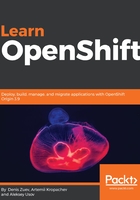
Using persistent storage
In the previous sections, we saw that containers can be created and deleted easily. But when a container is deleted, all the data associated with that container disappears too. That is why a lot of people refer to containers as a stateless architecture. But we can change this behavior and keep all the data by using persistent volumes. In order to enable persistent storage for a Docker container, we need to use the -v option, which binds the container filesystem to the host filesystem that runs that container.
In the next example, we will create a MariaDB container with persistent storage in the /mnt/data folder on the host. Then, we delete the MariaDB container and recreate it again using the same persistent storage.
First, remove all previously created containers:
$ docker rm -f $(docker ps -aq)
We have to prepare persistent storage on the node before we begin. Be aware that we need to give read/write permissions to the persistent storage directory. The MariaDB application works with a MySQL user with UID=999 inside the container. Also, it is important to mention that the special SE Linux security context svirt_sandbox_file_t is required. This can be achieved using the following commands:
# mkdir /mnt/data
# chown 999:999 /mnt/data
# chcon -Rt svirt_sandbox_file_t /mnt/data
The next step is to create the container running the MariaDB service:
$ docker run -d -v /mnt/data:/var/lib/mysql --name mariadb -e MYSQL_ROOT_PASSWORD=password mariadb
41139532924ef461420fbcaaa473d3030d10f853e1c98b6731840b0932973309
Run the docker ps command:
$ docker ps
CONTAINER ID IMAGE COMMAND CREATED STATUS PORTS NAMES
41139532924e mariadb "docker-entrypoint.sh" 4 seconds ago Up 3 seconds 3306/tcp mariadb
Create a new database and verify the existence of this new DB:
$ docker exec -it mariadb mysql -uroot -ppassword -e "create database persistent;"
$ docker exec -it mariadb mysql -uroot -ppassword -e "show databases;"
+--------------------+
| Database |
+--------------------+
| information_schema |
| mysql |
| performance_schema |
| persistent |
+--------------------+
Verify that there is new data in the /mnt/data directory created by the mariadb container. This is how we make the data persistent:
$ ls -l /mnt/data/
drwx------. 2 polkitd ssh_keys 4096 Mar 6 16:18 mysql
drwx------. 2 polkitd ssh_keys 20 Mar 6 16:18 performance_schema
drwx------. 2 polkitd ssh_keys 20 Mar 6 16:23 persistent
...
output truncated for brevity
...
Delete the mariadb container and verify that all files will be kept:
$ docker rm -f mariadb
mariadb
$ ls -l /mnt/data/
drwx------. 2 polkitd ssh_keys 4096 Mar 6 16:18 mysql
drwx------. 2 polkitd ssh_keys 20 Mar 6 16:18 performance_schema
drwx------. 2 polkitd ssh_keys 20 Mar 6 16:23 persistent
...
output truncated for brevity
...
We are going to rerun the container and verify whether the previously created database persistent survived container removal and creation:
$ docker run -d -v /mnt/data:/var/lib/mysql --name mariadb mariadb
c12292f089ccbe294cf3b9a80b9eb44e33c1493570415109effa7f397579b235
As you can see, the database with the name persistent is still here.
Remove all the containers before you proceed to the next section:
$ docker rm -f $(docker ps -aq)